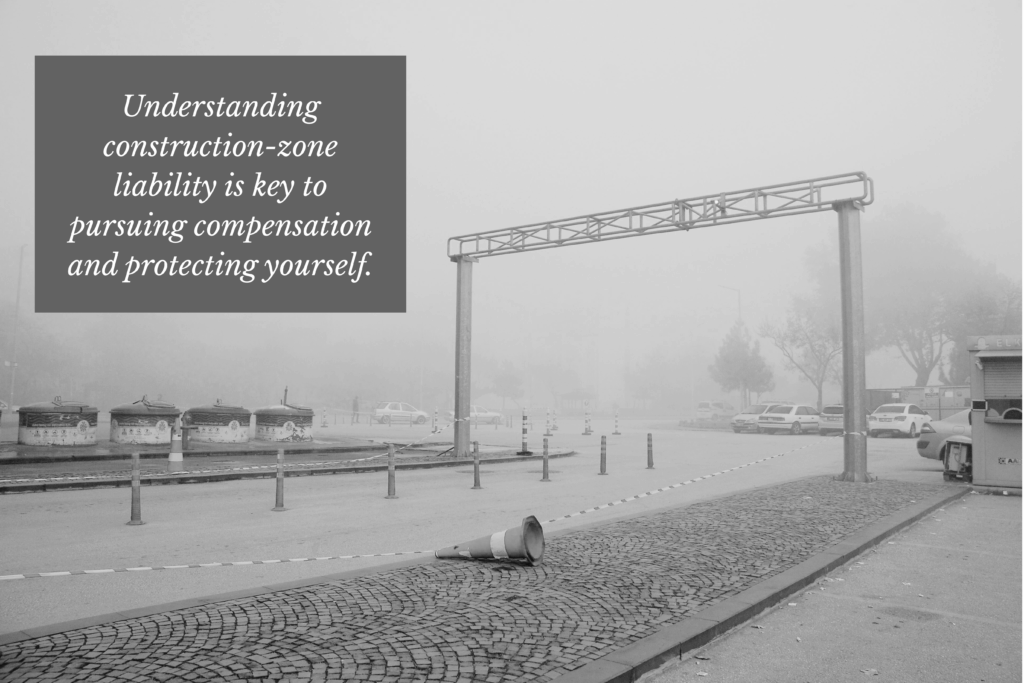Work zones are a necessary part of keeping New Mexico’s roads safe and functional. But when trucks enter the traffic mix, these zones can quickly become hotspots for serious accidents. In 2023, there were 9 work zone fatalities across the state, with 5 of them involving trucks. And over the past decade in the U.S., national data shows that fatal crashes in work zones have increased from 608 in 2014 to 818 in 2023, a 34% rise.
Whether it’s a semi barreling through a narrowed lane or a construction vehicle merging unexpectedly, the combination of heavy machinery, shifting traffic patterns, and reduced visibility creates a dangerous recipe for collisions. When a crash happens, the question of who’s responsible – the driver, the employer, or the road crew – isn’t always clear.
If you’ve been in a work-zone accident, read on to discover who may be liable for your injuries.
What Makes Work Zones So Dangerous for Trucks?
When a road or highway is under construction, the usual rules of the road shift, often quite literally. Truck drivers who already face challenges with visibility, braking distance, and maneuverability, are subject to a variety of changes that create dangerous situations:
- Sudden lane shifts – Temporary lane realignments can confuse drivers and create tight turns difficult for large trucks to navigate. A truck drifting even slightly outside its lane can sideswipe vehicles or construction barriers.
- Narrowed shoulders and lanes – Work zones often reduce shoulder space or compress lanes to make room for equipment and crews. This leaves little room for error, especially for trucks that need extra width and space to operate safely.
- Reduced speed limits and sudden slowdowns – Speed limits drop in work zones, but trucks traveling at high speeds may not be able to brake quickly enough when traffic suddenly slows, increasing the risk of rear-end collisions.
- Unpredictable equipment and worker movement – Construction vehicles may enter or exit the roadway without warning, and workers may be present just feet from active traffic. Trucks passing through must stay hyper-alert, as a single error in judgment can have devastating consequences.
- Poor visibility and inadequate signage – Night work zones, faded lane markings, or unclear detour signs can leave drivers guessing. Truckers may be unfamiliar with a specific area, which can lead to missed turns, abrupt lane changes, or even driving into closed sections of road.
Who’s at Fault in a New Mexico Work-Zone Truck Accident?

While it’s not hard to understand how these hazards could lead to an accident, it can be tough to determine who’s at fault. Understanding construction-zone liability is key to pursuing compensation and protecting yourself.
The truck driver
In many cases, fault lies with the truck driver, especially if they were speeding, distracted, or failed to adjust to the work zone’s reduced speed limits and lane changes. Commercial drivers are held to high safety standards, and ignoring work-zone warnings can be a serious breach.
The trucking company or employer
Even if the driver made a mistake, their employer may share liability. Trucking companies are responsible for training drivers, maintaining vehicles, and setting realistic delivery schedules. If a company pushes drivers to meet unreasonable deadlines or fails to address known safety issues, it could be held accountable under New Mexico’s vicarious liability laws.
Roadwork contractors and site managers
In some cases, the layout or signage of the work zone itself may be to blame. If lane shifts were poorly marked, speed limits weren’t posted, or equipment was left in active lanes, the contractor overseeing the site may bear responsibility. These claims can be complex and often require expert analysis of the work zone’s design and compliance with safety regulations.
Government entities
While rare, liability can sometimes extend to state or local agencies, especially if the work zone was improperly approved or maintained. These cases often involve additional legal hurdles, making it essential to consult an experienced attorney early.
What to Do if You’re in a Work-Zone Truck Accident
A truck crash in a work zone can be chaotic, confusing, and dangerous, but the steps you take immediately after can make a major difference in your recovery and legal case:
Step 1: Prioritize safety and medical help – First things first: If you or anyone else is injured, call 911 and seek medical attention immediately. Even if injuries seem minor, get checked out, as injuries may not be visible and symptoms can worsen over time. Medical records will be crucial for any future claim.
Step 2: Document the crash scene – Once it’s safe, take photos of the site, vehicle damage, road conditions, signage, and any nearby construction equipment. Work zones change quickly, so visual evidence of that moment in time can be crucial.
Step 3: Gather important information – Exchange contact and insurance details with everyone involved. If there were witnesses (including construction workers), collect their names and statements if possible. Be sure to note the name of the trucking company and any visible DOT numbers on the truck.
Step 4: Don’t admit fault – Work-zone crashes often involve multiple factors, and fault isn’t always obvious. Make sure you never say anything that could be interpreted as admitting blame, as insurance companies could use this to deny your claim or minimize your payout.
Step 5: Contact a personal injury attorney – Truck accidents can be complex, especially in work zones. A qualified truck accident lawyer can help you understand your rights, investigate the accident, and pursue compensation.
Kane Personal Injury Law has extensive experience with truck accident cases in New Mexico and offers free consultations to help you get started. Protect yourself by contacting one of our skilled attorneys today.
